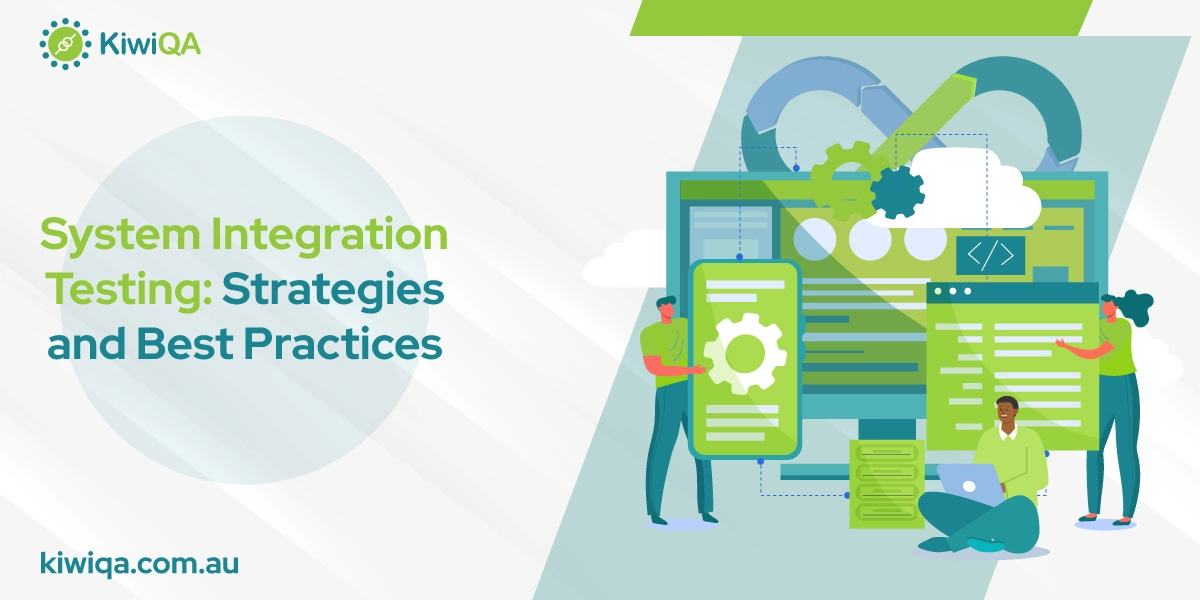Ultimate Guide to System Integration Testing: Strategies and Best Practices

 KiwiQA
KiwiQASystem integration testing plays a crucial role in the SDLC process. It aims to bridge the gap between the system testing & unit testing. The procedure involves a combination of software modules and testing them as a group. It ensures the function seamlessly together. The testing verifies that all the components are working together and meet the customer’s needs. In the following articles, we have mentioned the guide to what is system integration testing.
Want to get a brief about system integration testing definition? SIT is different from the unit and acceptance testing. In unit testing, a single application module is tested and performed prior to the integration testing.
The purpose of system integration testing is for businesses to maintain consistency and integration testing. This testing validates the reliability requirements and performance. It offers insight into the application behavior under different conditions. Ultimately, the testing also accelerates the quality and smooth user experience. Scroll further to learn about system integration testing examples.
Evaluating the appropriate system integration is not a simple process. You must choose the ideal subsystem, location, and nature of the relationship. Every business must understand the way stakeholders collaborate with the integration. What are the required processes, and what is the company’s aim? By understanding the integration points & the critical interfaces, businesses can run system integration smoothly.
Designing a system integration testing plan should be the priority for the software integration testing. The well-defined plan & strategies ensure the testing & validation are completed within budget. The following objectives need to be followed when developing a strategy for integration testing-
Utilizing necessary testing resources and methodologies is a must for successful integration testing. The system integration testing approach or methodologies ensure that every other aspect is thoroughly tested.
For successful execution of the integration testing, businesses need to adopt the ideal system integration testing tools. Here are some of the tools that can be used to perform integration testing: Tessy, LDRA, SITA, Citrus, etc.
A test case is a predetermined collection of components, circumstances for execution, testing strategies, and anticipated test outcomes. In contrast, use cases specify how applicable the testing procedure is. To effectively carry out testing for integration, the test & use cases for the unit tests must be determined according to particular software units, characteristics, software creation requirements, and various other variables.
Looking for system integration testing best practices? Continuity and the availability and accuracy of all required data are ensured through maintaining the testing environment. Any problems found throughout testing may be quickly duplicated, which facilitates detection and resolution. Updating and correctly configuring both software and hardware will help sustain the testing environment.
Maintain data and environment used for validation and testing so you can promptly recover it in the event of a problem. To avoid unintentionally altering the production environment, make sure the testing environments are segregated from it. Record the environment used for testing, together with both software and hardware setup.
Through early evaluation in the development phase and ongoing testing, businesses can guarantee that any flaws are found early on and fixed before launching. Initial automation testing services can also cut significantly the total cost & testing duration of the testing. Throughout the development phase, guarantee that the incorporated system is continually tested and validated to ensure any modifications don’t cause new problems.
Through Continuous integration and testing procedures, organizations can guarantee the process’s effectiveness and productivity. To find opportunities for improvement, continuously assess the integration testing procedure. It utilizes metrics to assess how well the testing process is working and pinpoint areas that require more testing. Make improvements to the evaluation and verification cases, circumstances, and data by using the lessons discovered from prior rounds of testing. Observe the devices and resources being used for testing and validation and assess any new ones that can enhance the procedure.
Risk-based testing is the greatest option for a QA team that finds it difficult to choose when to spend both energy and time. This is an approach to testing that establishes testing objectives based on “defined risk.” The risk-based testing strategy arranges testing activities to reduce the amount of remaining product risk once the program is put into use. Testing assessment, preparation, estimating, design, operation, and outcome can be benefited through this.
A study by the National Institute of Standards and Technology (NIST) highlights the critical nature of early testing stages, including system integration testing, indicating that catching and fixing bugs in these stages can reduce project costs by up to 30%. This underscores the importance of a comprehensive SIT strategy to mitigate risks effectively and ensure a smoother transition through subsequent development phases.
The incremental approach adds components one at a time or according to necessity. The modules that have been chosen must make sense together. Typically, more than one module is installed and then tested to make sure it performs as planned. Testing doesn’t stop until every module has passed approval.
In this kind of assessment, the dependent units interlink with each other. Examine at least two modules and see if there is adequate data flow between them. If so, you may add additional modules and run the test once more. This testing is performed under two approaches: one is the top-down approach & other is a bottom-up approach.
In the SDLC process, end-to-end testing refers to a thorough testing methodology in which a whole software program is tested from beginning to end. It simulates actual user situations and seeks to confirm that the software operates flawlessly as a whole. Every interconnected part and system component is tested from start to finish. End-to-end testing has the potential to spot problems that integration and unit testing could overlook. They assist in finding hidden problems, assessing effectiveness, and ensuring that every component functions as a whole.
Verifying non-functional specifications is known as cross-functional testing. These specifications are the kinds of system features that are impossible to implement as regular features. Regular communication & collaboration between the testing, development, and operational teams is necessary for effective testing.
Integration testing can be quite time-consuming and prone to mistakes when it is done manually. These resources are utilized to test the module-to-module interface and identify any issues that may arise from the integration of several modules. They provide programmers with a thorough report of any defects or faults that require to be fixed. However, because there are so many alternatives available, selecting the best integration testing tool for the work can be difficult. The popularity is determined by factors including ease of use, license cost, supported languages, result display, etc.
The testing process consists of several parties. For successful testing, these roles must effectively collaborate. Furthermore, it is difficult to serve various stakeholders with one tool due to their diverse skill sets.
It might be quite difficult to locate a common tool that’s compatible with numerous technologies because these apps adhere to distinct rules, regulations, and constraints. By following the above content, you will already know about the types of system integration testing. So, different testing types require different resources.
The range of testing expands with the size of the software solution. Maintaining them gets more difficult as the number of test cases rises. Teams now prioritize maintenance above development.
Test score metrics, method level metrics, statistics based on data coverage, and dependency edges are the main metrics used to assess the efficacy of integration testing. These metrics make it easier to monitor how system components communicate with one another, identify connections that are prone to errors, and concentrate efforts to test these links.
A project’s success may be measured to see if it is meeting its goals and to discover any areas that could require improvement. Feedback loops are another way to accelerate the testing procedure.
Service virtualization is a potent software testing approach that helps enterprises address issues with stress testing, identical testing, interaction with external systems, and unavailable services. Businesses can opt for security testing services to understand more about this approach. The QA team experts will make you aware of the Performance and load-testing strategies.
Integration testing is considered as the procedure where different interfaces and software are verified as a group. Integration testing shows the QA team how well the different elements of the software work together. The organization must perform this testing to ensure seamless communication.
By concluding the above-discussed part, we can say that integration testing is a crucial part of the process of SDLC. The following process is necessary to verify that the modules perform according to the designed criteria. By embracing this testing, a business can confidently release its software in the market.
Subscribe to our newsletter for some hand-picked insights and trends! Join our community and be the first to know about what's exciting in software testing.
Welcome to the testing tales that explore the depths of software quality assurance. Find valuable insights, industry trends, and best practices for professionals and enthusiasts.

Fill out and submit the form below, we will get back to you with a plan.
 CRN:
22318-Q15-001
CRN:
22318-Q15-001 CRN:22318-ISN-001
CRN:22318-ISN-001 CRN:22318-IST-001
CRN:22318-IST-001